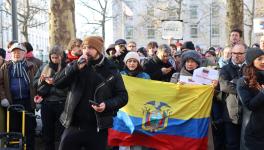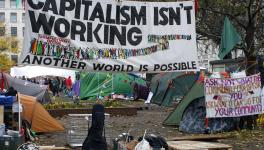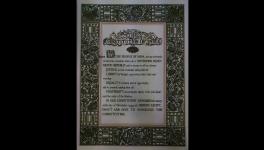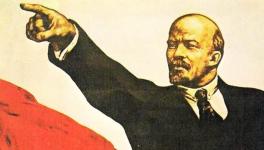Early Legacy of the Bolshevik Revolution
Representational use only.Image Courtesy: Flickr
In October 1917, when the Bolsheviks under the leadership of Lenin captured power in Russia the message was simple: that the meek can inherit the world. Unlike the French and English revolutions, the Bolshevik Revolution was a planned and conscious attempt to take power by the organised working class with the support of the poor peasantry.
It was the biggest political event in the 20th century, primarily because it shook all integuments of exploitation. Be it class, race, gender, or capitalist imperialism. No other event in history had such a long-ranging impact than the Bolshevik Revolution.
The French Revolution, for example, spoke of the Rights of Man but failed to give voting rights to women. It spoke of the equality of all men yet Napoleonic France continued to have slave colonies in the Caribbean. The tenacity of the French to hold on to slavery was reflected in the gruesome murder of Toussaint Louverture, the leader of the slave revolt in Haiti.
The Bolshevik Revolution, on the other hand, remained steadfast to its promises. In the absence of slavery, the worst sufferers of the Tsarist regime were Jews. The Tsars had for long pandered and promoted anti-Jewish sentiments to channelise the anger of the poor in pogroms. Lenin and the Bolsheviks understood this well.
In a lecture on the 1905 Revolution in Zurich, Lenin said: ‘‘Tsarism knew perfectly well how to play up to the most despicable prejudices of the most ignorant strata of the population against the Jews, in order to organise, if not to lead directly, the pogroms—those atrocious massacres of peaceful Jews, their wives and children, which have roused such disgust throughout the whole civilised world’’.
Every socialist and communist must remember with great pride, especially when fake anti-semitism has become a renewed weapon to attack the Left in the world, that in 1914, the Bolshevik party in the Tsarist Duma proposed a Bill that aimed to ‘‘to remove all limitations of rights placed upon the Jews, and all limitations whatsoever connected with descent from or membership of any particular nationality’’.
It was the radical progressivism of the Bolsheviks that led to a Jew becoming the second in command of the revolutionary state. Shaken and concerned by that Marxist Jew, the American Raymond Robins, depicted him as ‘‘a son of a bitch, but the greatest Jew since Jesus Christ’’. He was Leon Trotsky who went on to plan the revolutionary takeover in October 1917 and became the Commander-in-Chief of the Red Army.
Apart from Trotsky, Jews constituted a good number of senior Bolshevik party members such as Zinoviev, Kamenev, Yakov Sverdlov, Maxim Litvinov, and Moisei Uritsky. Compare this to the United States of America wherein it took 232 years for a Black American to become President of the United States.
The Gender Question
On the question of gender, the Bolshevik party’s programme written in 1903 included the demand for ‘complete equality of rights for men and women. Nadia Krupskaya, Lenin’s wife and a long-time member of the Bolshevik Party, wrote a pamphlet in 1902 titled The Woman Worker. It recorded the abject miseries of women in the face of famines and the extremely low wages that amounted to roughly four-fifth of the male wage despite working for eleven and a half hours a day.
The pamphlet linked the emancipation of the working class as a whole to the emancipation of women. During the famous 1907 international socialist conference of the Second International, Lenin condemned the opportunist actions of the Austrian Social-Democrats who, while conducting a campaign for electoral rights for men, put off the struggle for electoral rights for women to ‘a later date’.
On the eve of the Bolshevik Revolution, Alexandra Kollontai led a march of 15,000 women, mainly the wives of the Russian soldiers fighting the First World War. Whilst the men were fighting on the front, the womenfolk joined factories in huge numbers.
Lenin officially committed the Bolshevik party to free education for girls, and their economic demands, such as workplace creches, time off for breastfeeding and paid maternity leave. Judy Cox in her essay, Out of the shadows: Female Leninists and Russian Socialism, writes that ‘‘the Bolsheviks were becoming the political home of working women who increasingly understood that opposition to the war entailed opposition to capitalism itself’’.
Within a few weeks of the revolution, medical services were made free to all women, doctors were given a state wage and all childcare institutions were brought under government control. For the first time, the right to equal pay for women along with an eight-hour workday were duly passed as legislations. The Bolshevik pledges of paid maternity leave and time off for breastfeeding were also implemented. A law of December 1917 removed all obstacles to divorce. The new Family Law of October 1918 made declared all marriages to be secular. Thus, making marriages no more an intensely sacral affair mediated by the Orthodox Church. It also provided for the economic independence and equality of women in marriage, and imposed paternal responsibility for all children, whether born in wedlock or not.
Bolshevik Russia was also the first state to decriminalise homosexuality as early as in 1917.
Abortion was legalised in November 1920 making the Soviet Union the first state to do so. Ironically, in the same year, capitalist-imperialist France enacted a law that forbade all forms of contraception. The Land Law of 1922 gave women ownership of their family's farm and allowed them to receive their share of the property even upon divorce.
All this was happening when European imperial powers, such as Britain and France, did not have universal suffrage rights for women. In the former, it came only in 1928 and the latter delayed it till 1944. Switzerland gave women the right to vote in 1971-1972, and ironically the Swiss canton of Appenzell gave voting rights to women as late as 1991—the year the Soviet Union collapsed!
Nadia Krupskaya noted that the number of women members in the Communist Party of the Soviet Union went up from 40,000 in 1922 as many as 5,00,000 by October 1932. And at the time when the 15th anniversary of the October Revolution was observed, 20-25% of the deputies of the village Soviets, district executive committees, and city Soviets were women.
Opressed Nationalities
On the question of oppressed nationalities, the legacy of the Bolshevik Revolution remains unmatched. Lenin and the Bolsheviks’ steadfastness against colonialism could be traced to the 1907 international socialist conference. Anti-communist scholarship has tried to explain Lenin’s radical position on the political emancipation of the colonies in two ways.
First, the final defeat of Alexander Kolchak and Anton Denikin, two internationally recognised leaders of the white counter-revolution allowed Lenin and the Bolsheviks to bring under control the eastern borderlands which had declared independence right after 1917. The argument goes that this allowed the Soviet Union for a much-needed contiguity with Asia thereby easing the way to draw in the agitating masses into the vortex of the Bolshevik Revolution.
Second, the rising tide of anti-colonial nationalism in the colonised nations of Asia pushed Lenin toward espousing the cause of the colonies wholesale. Both arguments could be dislodged from their perches of academic acceptance if one looks a little deep into history.
During the 1907 international socialist conference at Stuttgart, Germany, the question of the colonies was on the table. It was at this very conference that an Indian nationalist, Bhikaji Cama, hoisted the ‘Flag of Indian Independence’ with Vande Mataram emblazoned on it. Yet, the question of the colonies received lukewarm attention at best and opportunistic vacillation, at worst.
Henri Hubert Van Kol, a prominent socialist member of the Dutch Parliament, who in the past argued that ‘the moral requirement of the (imperial) government was first to care for the needs of the indigenous people, and only secondly to promote capitalist exploitation’, dominated the Colonial Commission of the congress. He framed a Draft Resolution to the effect that the Stuttgart Congress did not in principle oppose colonialism as such ‘for even under socialism, colonialism would have had a civilizing role to play.’ It was Lenin, who, along with Rosa Luxembourg and other German Left Social Democrats, defeated Van Kol’s opportunist and unprincipled Draft Resolution.
In the very next year, Lenin wrote a pamphlet titled Inflammable Material in World Politics wherein he argued that ‘‘there can be no doubt that the age-old plunder of India by the British, and the contemporary struggle of all these ‘advanced’ Europeans against Persian and Indian democracy, will steal millions, tens of millions of proletarians in Asia to wage a struggle against their oppressors’’.
After the revolution, the Bolsheviks were the first and the only government to demand the unconditional emancipation of all colonies from the clutches of capitalist-imperialist powers. The establishment of the Communist International (COMINTERN) in 1919 was exactly to serve this purpose. In world history hitherto, no other such international organisation was ever made, either in scope, aims, vision, and radical internationalism.
Another important aspect that is often not discussed is that of the Muslim ethnic nationalities of Central Asia. Constituting about 13% population of Soviet Russia, the central Asian republics were one of the most backward regions of the world. With a legacy of the dual oppression of parasitic Khans and the Tsars, the Muslim population had suffered horrendous ordeals. The last of which was the violent repression of the 1916 rebellion against forceful conscription for the First World War wherein almost 83,000 Muslims lost their lives. This radicalised and brought the jadedi Muslims into the fold of the Bolsheviks. A declaration: To all the Muslim workers of Russia and the East, issued by the Soviet government on November 24, 1917, stated: ‘‘Muslims of Russia ... all you whose mosques and prayer houses have been destroyed, whose beliefs and customs have been trampled upon by the tsars and oppressors of Russia: your beliefs and practices, your national and cultural institutions are forever free and inviolate. Know that your rights, like those of all the peoples of Russia, are under the mighty protection of the revolution…’’.
David Crouch in his brilliant essay, The Bolsheviks and Islam, has given a glimpse into the attitudes of the time could be found in a Professor in Japan and later an advisor to the King of Afghanistan, Mohammed Barkatullah’s pamphlet Bolshevism and the Islamic Body Politic which he was distributing in Turkestan. A copy fell into the hands of the British secret service in India, who translated it from Persian.
It is worth quoting at some length: ‘‘following on the dark long nights of tsarist autocracy, the dawn of human freedom has appeared on the Russian horizon, with Lenin as the shining sun giving light and splendour to this day of human happiness...the administration of the extensive territories of Russia and Turkestan has been placed in the hands of labourers, cultivators, and soldiers. The distinction of race, religion, and class has disappeared ... But the enemy of this pure, unique republic is British imperialism, which hopes to keep Asiatic nations in a state of eternal thraldom… time has come for Muhammedans of the world and Asiatic nations to understand the noble principles of Russian socialism and to embrace it seriously and enthusiastically… They should, without loss of time, send their children to Russian schools to learn modern sciences, noble arts, practical physics, chemistry, mechanics, etc. Oh, Muhammedans! Listen to this divine cry. Respond to this call of liberty, equality, and brothership which brother Lenin and the Soviet government of Russia are offering you.’’
Trotsky in his 1923 book, Problems of Everyday Life: Creating the Foundations for a New Society in Revolutionary Russia, noted that in Turkestan and in certain other national republics, a notable percentage of communist party members, roughly 15%, were believers in Islam.
Summing up the attitudes of the Bolshevik leadership to religion he wrote: ‘‘Of course, it would be better if we had a proletariat there (in Central Asia) that had already had experience in strikes and bouts with the church, that had rejected the old prejudices and only then come to communism. That's how it is in Europe, and, to a certain degree, it has been and continues to be that way in the centre of our country. But the East is lacking all this previous schooling. There, our party is the elementary school, and it must fulfill its responsibility accordingly. We will admit into our ranks those comrades who have yet to break with religion not in order to reconcile Marxism with Islam, but rather tactfully but persistently to free the backward members' consciousnesses of superstition, which in its very essence is the mortal enemy of communism.’’
Soon, a massive programme of what would now be called affirmative action was introduced, known as ‘korenizatsiia’ or ‘indigenisation’. It started with kicking out the Russian and Cossack colonists and their ideologues in the Russian Orthodox church. The Russian language ceased to dominate, and native languages returned to schools, government, and publishing. Indigenous people were promoted to leading positions in the state and communist parties and given preference over Russians in employment. Both, primary education institutions and universities sprang up soon after the civil war ended.
Let us take the example of Tajikistan. Ruled by the Emir of Bokhara, Tajikistan became an autonomous republic in 1925 and in 1929 it entered the Union of Soviet Socialist Republics (USSR) as an independent federated republic. In colonial India, in 1911, as many as 6% of the people were reported to have been literate. In Tajikistan, before the Revolution, only one-half of 1% of the population could read and write. In 1931, the Indian figure of literacy rose by just 2% touching the 8% mark. Whereas by 1933, a good 63% of the population was literate in Tajikistan. There were only a hundred Tajik students at school in 1914. The figure in 1939 was 328,000. By 1936, the Republic had one school per 500 of the population, five higher educational institutions, and over 30 technical schools.
The progress in public health was also phenomenal. In 1914, there were just 13 doctors in Tajikistan who would be called upon to cater only to the needs of the feudal aristocracy. In 1939, there were 440 doctors, ready for service in every home. In 1914, there were no maternity beds in the abysmally ill-equipped hospitals. In 1937, there were 240. In 1914, there was no such thing as a maternity and infant welfare centre. Twenty-three years later there were 36 such centres.
A mention must also be made of the work done by the Central Commission for Agitation and Propaganda Among Working Women (Zhenotdel). After the civil war ended Zhenotdel workers travelled to Central Asia, organising “red yurts” and “red boats” to reach out to Muslim women. In the autumn of 1918, over 1,000 women gathered for the first All-Russian Women’s Congress. After prolonged debates, congress voted for an eight-hour working day, the abolition of private landed property, confiscation without indemnity of large properties, equality of political rights for women, and an end to polygamy and purdah. The congress meant that Russia’s Muslims were the first in the world to free women from the restrictions typical of Islamic societies of that period.
To conclude, the essay has attempted to show only some emancipatory facets of the Bolshevik Revolution. A lot more can be said, and reams could be written about the glorious legacy of the Revolution. However, in the absence of time and space, the best way to celebrate the Revolution would be to plan one in India!
The writer is a research ccholar in the Department of Political Science, University of Connecticut,US. The views are personal.
Get the latest reports & analysis with people's perspective on Protests, movements & deep analytical videos, discussions of the current affairs in your Telegram app. Subscribe to NewsClick's Telegram channel & get Real-Time updates on stories, as they get published on our website.
























